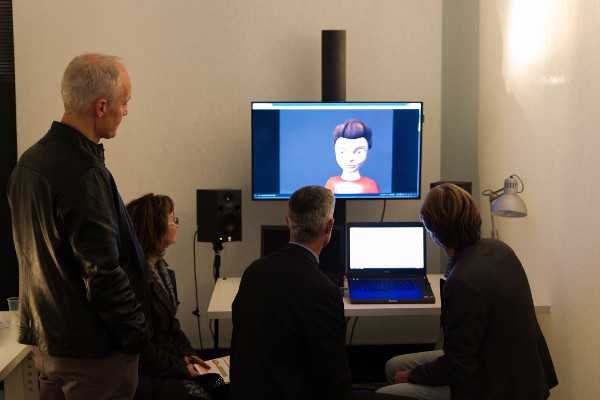Section: New Results
Knowledge-based Models for Narrative Design
Our long term goal is to develop high-level models helping users to express and convey their own narrative content (from fiction stories to more practical educational or demonstrative scenarios). Before being able to specify the narration, a first step is to define models able to express some a priori knowledge on the background scene and on the object(s) or character(s) of interest. Our first goal is to develop 3D ontologies able to express such knowledge. The second goal is to define a representation for narration, to be used in future storyboarding frameworks and virtual direction tools. Our last goal is to develop high-level models for virtual cinematography such as rule-based cameras able to automatically follow the ongoing action and semi-automatic editing tools enabling to easily convey the narration via a movie.
Virtual direction tools
Participants : Adela Barbulescu, Rémi Ronfard.
During the third year of Adela Barbulescu's PhD thesis, we proposed a solution for converting a neutral speech animation of a virtual actor (talking head) to an expressive animation. Using a database of expressive audiovisual speech recordings, we learned generative models of audiovisual prosody for 16 dramatic attitudes (seductive, hesitant, jealous, scandalized, etc.) and proposed methods for transferring them to novel examples. Our results demonstrate that the parameters which describe an expressive performance present person-specific signatures and can be generated using spatio-temporal trajectories; parameters such as voice spectrum can be obtained at frame-level, while voice pitch, eyebrow raising or head movement depend both on the frame and the temporal position at phrase-level. This work was presented at the first joint conference on facial animation and audio-visual speech processing [16] and in a live demo at the EXPERIMENTA exhibition in Grenoble, and was seen by 1200 visitors.
Virtual cinematogaphy
Participants : Quentin Galvane, Rémi Ronfard.
|
During the third year of Quentin Galvane's Phd thesis, we proposed a solution for planning complex camera trajectories in crowded animation scenes [2] Galvane [18] . This work was done in a collaboration with Marc Christie in Rennes.
We also published new results from Vineet Gandhi's PhD thesis (defended in 2014) on the generation of cinematographic rushes from single-view recordings of theatre performances [32] . In that paper, we demonstrate how to use our algorithms to generate a large range of dynamic shot compositions from a single static view, a process which we call "vertical editing". Our patent application on this topic was reviewed positively and is being extended.
Those techniques were used to automatically generated cinematographically pleasant rushes from a monitor camera during rehearsals at Theatre des Celestins, as part of ANR project "Spectacle-en-Lignes". Results of the projects are described in two papers [28] , Steiner [30] and we presented them to a professional audience during the Avignon theatre festival. This work was done in a collaboration with the Institut de Recherche et d'Innovation (IRI) at Centre Pompidou and the SYLEX team at LIRIS.
Film editing & narrative design
Participants : Quentin Galvane, Rémi Ronfard.
|
We proposed a new computational model for film editing at the AAAI artificial intelligence conference, which is based on semi-Makov chains [20] . Our model significantly extends previous work by explicitly taking into account the crucial aspect of timing (pacing) in film editing. Our proposal is illustrated with a reconstruction of a famous scene of the movie "Back to the future" in 3D animation, and a comparison of our automatic film editing algorithms with the director's version. Results are further discussed in two companion papers [31] , Galvane [19] . This work was done in a collaboration with Marc Christie in Rennes. Future work is being planned to extend this important work to the case of live-action video (as described in the previous section) and to generalize for the case non-linear film editing including temporal ellipses and flashbacks.




